
The last time we touched base about Helsinki it was early April, and we found ourselves caught in the middle of a tug-of-war between sun and snow. It seems, and we must stress with fingers crossed, it seems, that good weather is here to stay, and that Spring has overcome. Almost all the snow has melted and the frozen harbors have opened up, adding a beautiful addition of reflected, rippling light to the city. Though the days are still chilly, the sun doesn’t set until after 9pm, and the city is alive like we have never seen before. Indeed, the Finns have come out of hibernation and brought with them their street café tables and idiosyncratic sense of style. With each day we get 5 additional minutes of light, and after a long, dark, and snowy winter, people just can’t get enough of it, including ourselves. Now that we are through cataloguing our exhaustive spring break tour, we have a lot to share with you about what’s going on and what we are doing in Finland. Here you have it: Panorama Looking South from Construction Site
Panorama Looking South from Construction Site
Helsinki Under Construction
In the last installment of our Finnish Building Technologies class, we shared our afternoon workshop dealing with the science and design of people flow and vertical circulation at the Kone Headquarters. In this entry we share a recent tour of a new office building under construction in downtown Helsinki. It was designed by the 19-man firm JKMM Architects, most noted for their design of the Finnish Pavilion at the 2010 Shanghai Expo.
Standard Construction-side Street Poster
Accompanying us was Juha Mäki- Jyllilä, partner of JKMM (he represents the second M), to tour the 160,000 sq. ft. office building, and to call out particular points of interest dealing with the construction and the technical design development. It will be the new head quarters for the Alma Media company, and it is just one of many new developments underway in an effort to reclaim vacant land in the downtown.

Juha explains the system of nested mechanical ducts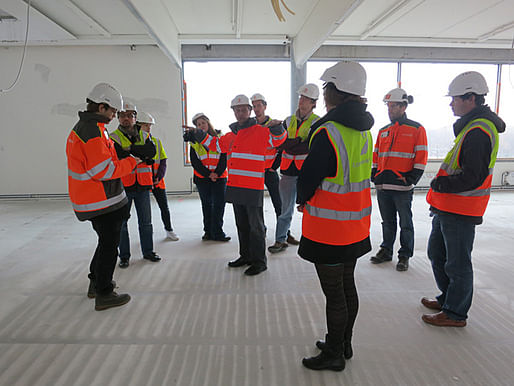 Our professor, Architect Kimmo Friman, points out the logic of the structural loads
Our professor, Architect Kimmo Friman, points out the logic of the structural loads 
The Red Herring's very own Brian Driska, discovers a design flaw!
The site was once a brackish bay that was filled in about 100 years ago for grain warehouses. It is located at a prominent site: adjacent to the central railway station tracks, just north of Steven Holl’s Kiasma museum, and a visual neighbor to Alvar Aalto’s sacrosanct Finlandia Hall. 
Location of site Current encampment of Occupy Helsinki Movement. The last remains of the old brick Grain Factories are just visible behind.
Current encampment of Occupy Helsinki Movement. The last remains of the old brick Grain Factories are just visible behind. Looking southeast over train tracks. Cupola of Senate Square Cathedral on the Skyline.
Looking southeast over train tracks. Cupola of Senate Square Cathedral on the Skyline.  Looking north up the tracks. Kallio neighborhood to the right, future office buildings to the left.
Looking north up the tracks. Kallio neighborhood to the right, future office buildings to the left.

Looking south over more construction sites. Central station to left, Holl's Kiasma to right.
Looking west over the lake. Direct view of Aalto's marble Finlandia Hall.
While the architecture of the office is not the most enthralling we have seen due to budget constraints, it is noted for the exceptional fact that the basement floor is at a depth below sea level and houses the mechanical equipment. This has required a complex and expensive double thick foundation slab and concrete floor.  Deep, thick, cavernous. The below-sea level basement is mostly a parking garage. This site was an ocean 100 years ago, so to prevent the building from sinking, it is reinforced with a double thick concrete and steel foundation, a double thick slab, and a tight grid of piles.
Deep, thick, cavernous. The below-sea level basement is mostly a parking garage. This site was an ocean 100 years ago, so to prevent the building from sinking, it is reinforced with a double thick concrete and steel foundation, a double thick slab, and a tight grid of piles. 
Right off the technical mechanical room, the massive and snaking HVAC ducts. 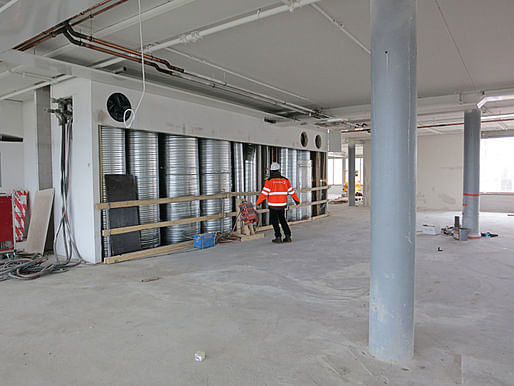
Efficiently compartmentalized duct shafts sit at each end and act as additional buffer to fire stairs.
Budget aside, there were many nice moments throughout the space, and it was a great opportunity to get on site and examine a building without its skin, and hear the designer explain the logic of its bones, ligaments, veins, and organs.

Attractive prefab steel stair that couples as a structural member for slab.
Delicate and light exposed spiral fire stair
Looking up spiral stair Finished flooring will be of textile. Weightless effect to just "kiss" the ground.
Finished flooring will be of textile. Weightless effect to just "kiss" the ground. Main lobby, rebar sheets and pre-poured ramp.
Main lobby, rebar sheets and pre-poured ramp.
Construction began about a year ago and is projected to complete by December of this year. The other offices in the area have just begun construction as well. This is just one of many many examples here in the city where one sees large scale construction development. It is what results from an optimism for growth accompanying a careful master plan to densify the center, reclaim industrial sectors, and discourage sprawl.
As in Stockholm, Copenhagen, Malmö, and Olso, Helsinki is very much under construction.
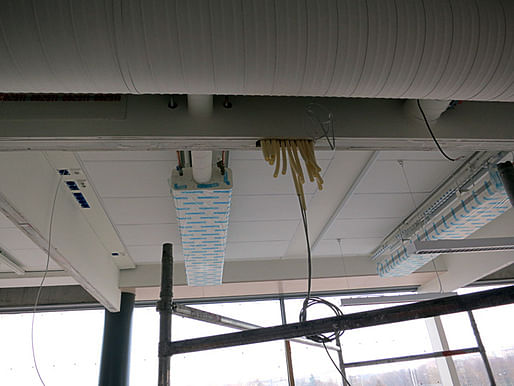 Loose conduits
Loose conduits

Clearly they just used a simple trim command in Rhino for this one.
Steel Columns and Steel Beams. A simple cubicle structure system, because of costs the overall design had to be rather conventional with freedom for a few nicely articulated nibbles.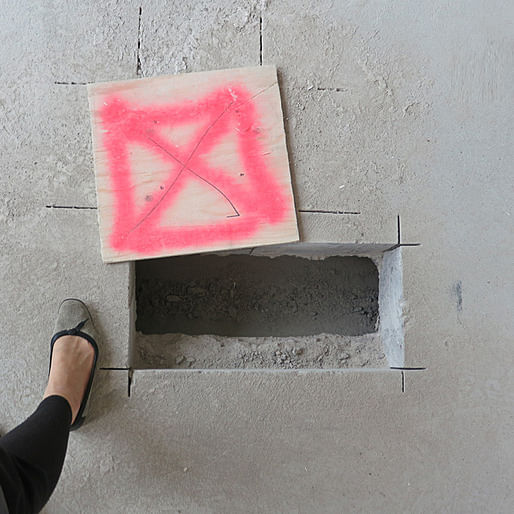 Accessible electrical conduit path runs regularly through the floor slabs
Accessible electrical conduit path runs regularly through the floor slabs
Plywood covering finished fire stair material for protection during construction

Aluminum framed windows. The little squares you see are pieces of cork adhesive stuck to the panes, this prevents the panes from scratching when they are brought in stacked, and also allows workers to recognize a glass wall is there so they do not accidentally knock a 2x4 through it when they swing around. FInlandia Hall and Töölö neighborhood in distance.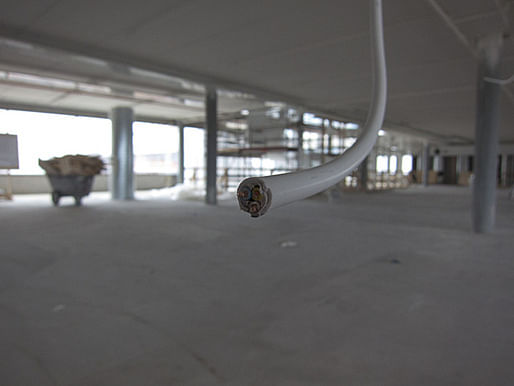
Conduit looking for love.
This work by A.D.Morley & J.A.Wong is licensed under a Creative Commons Attribution-NonCommercial-NoDerivs 3.0 Unported License.
A new adventure begins as we finish one chapter; we hope to share our story with you. We are graduates of Washington University in St. Louis, Sam Fox School of Design & Visual Arts.
No Comments
Block this user
Are you sure you want to block this user and hide all related comments throughout the site?
Archinect
This is your first comment on Archinect. Your comment will be visible once approved.